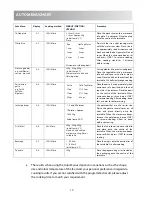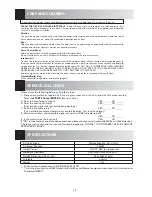
GLASSW
ARE/CERAMIC
(HEA
T RESIST
ANT)
MET
AL COOKW
ARE
PLASTIC WRAP/
OVEN BAGS
ALUMINIUM FOIL
STRA
W AND WOOD
P
APER
PLASTIC COOKW
ARE
MICROW
A
VE SAFE
BROWNING DISH
THERMOMETERS
•
MICROW
A
VE SAFE
•
CONVENTIONAL
GLASSW
ARE
•
Ordinary glass is not suitable for cooking but may be used for short periods for heating foods.
CERAMIC
•
Most ovenproof china, and ceramics, are suited.
•
A
void dishes that are decorated with gold or silver leaf.
•
A
void using antique pottery
.
•
If unsure, check with the manufacturer
.
•
Metal cookware should be avoided when cooking in the microwave oven.
•
Microwave energy is refl
ected by metal.
•
Plastic wrap can be used to cover food.
•
Some shrinkage of the wrap may occur
, over an extended cooking time.
•
When removing wrap, lift it in such a way to avoid steam burns.
•
Do not tie oven bags with metal twist ties, substitute with string.
•
For cooking food with high fat content, do not bring the wrap in contact with the food as it may melt.
•
Small amounts may be used to shield certain parts of meat and fi
sh when cooking or defrosting.
•
Remove food in foil trays, if possible, and place in a microwave safe dish.
•
If not possible, place the foil tray onto a heat proof plate allowing 2.5 cm between the walls of the oven.
•
Excessive over heating of these materials may cause a fi
re in the microwave oven.
•
Paper towels and waxed paper are suitable to use to prevent splatters.
•
These are suitable for use when reheating foods or for short cooking times.
•
Ideal for cooking, reheating and defrosting.
•
Some microwave safe plastic cookware are not suitable for cooking foods with high fat and sugar content.
•
Ensure that the preheating time of the dish is not exceeded.
•
Ensure that a microwave heat proof dinner plate or suitable insulator be placed between the turntable and the browning
dish.
YES
NO
YES
FOR
SHIELDING
NO
YES
YES
YES
YES
NO
MICROW
A
VE
SAFE ONL
Y
Advice
Use
Utensil
( )
A-5
COOKING AND UTENSIL GUIDE




































